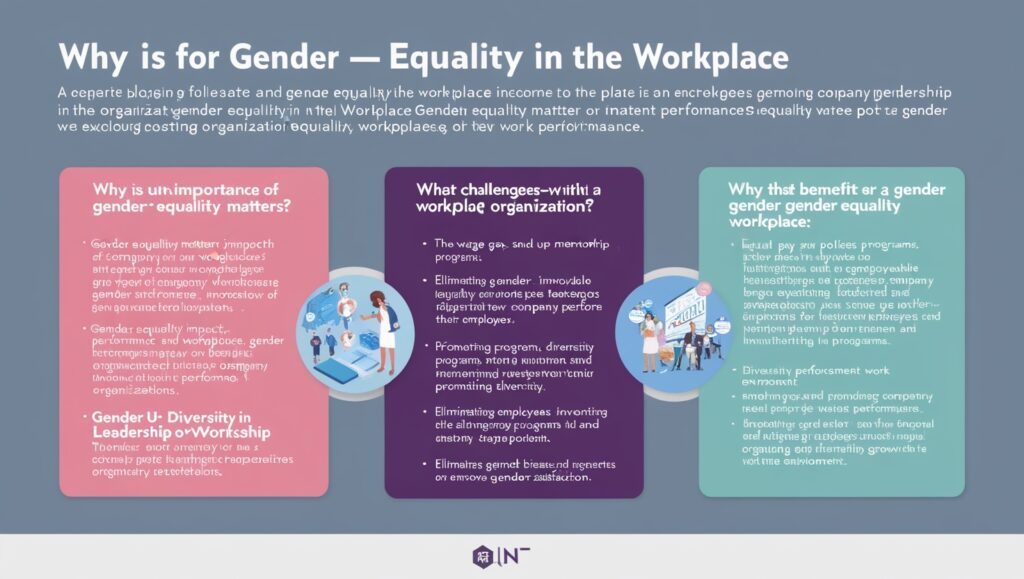The Importance of Gender Equality in the Workplace
Gender equality in the workplace is not just a moral imperative; it is also a crucial aspect of building a thriving, innovative, and productive organization. Ensuring that men and women have the same opportunities, rights, and responsibilities at work benefits both individuals and companies in significant ways. By fostering an environment that values gender diversity and inclusivity, businesses can unlock greater potential, enhance creativity, and promote a positive work culture.
In this blog, we will explore why gender equality is essential, its benefits for the workplace, challenges that organizations face, and actionable strategies to promote a more equitable environment for everyone.
What is Gender Equality in the Workplace?
Gender equality in the workplace means that all employees, regardless of their gender, have access to the same resources, opportunities, and treatment. This includes equal pay for equal work, equitable distribution of leadership roles, and a culture that supports work-life balance for all employees. It is about creating an environment where everyone feels respected, valued, and empowered to reach their full potential without fear of discrimination or bias.
Why is Gender Equality Important?
1. Fosters Innovation and Creativity
Diverse teams bring different perspectives, ideas, and approaches to problem-solving. When gender equality is prioritized, workplaces can benefit from a broader range of viewpoints that fuel innovation and creativity. Studies have shown that companies with higher gender diversity are more likely to develop innovative products and solutions.
2. Enhances Company Performance
Research has consistently demonstrated that gender-diverse organizations tend to outperform their less diverse counterparts. For example, McKinsey’s 2020 report found that companies in the top quartile for gender diversity on executive teams were 25% more likely to have above-average profitability compared to those in the bottom quartile. This is because diverse leadership teams are more adept at making strategic decisions and responding to market demands.
3. Improves Employee Satisfaction and Retention
An inclusive work environment that values gender equality fosters a sense of belonging among employees. This leads to higher job satisfaction and lower turnover rates. When employees feel respected and acknowledged, they are more likely to stay committed to the organization and perform at their best.
4. Promotes Economic Growth
On a larger scale, gender equality contributes to economic development. According to the International Labour Organization (ILO), reducing the gender gap in labor participation can boost GDP growth. When more women are included in the workforce, economies become more diverse and resilient.
Challenges to Achieving Gender Equality
Despite progress in recent years, achieving true gender equality remains a challenge. Some common barriers include:
1. Wage Gap
One of the most persistent issues is the gender pay gap, where women are often paid less than men for doing the same work. This disparity can be attributed to factors such as discrimination, the undervaluation of roles typically held by women, and fewer opportunities for promotions.
2. Underrepresentation in Leadership
Women are underrepresented in leadership positions across many industries. The “glass ceiling” effect often prevents women from advancing into executive roles, limiting their influence and contributions to decision-making processes.
3. Workplace Bias and Stereotypes
Implicit biases and gender stereotypes continue to exist in workplaces, affecting hiring, promotions, and project assignments. For example, women may be perceived as less committed to their careers due to potential caregiving responsibilities, which can hinder their career progression.
4. Work-Life Balance
Balancing work and personal life is a challenge that disproportionately affects women, particularly those who have caregiving responsibilities. In many cases, inadequate parental leave policies and flexible working options make it difficult for women to thrive professionally.
Strategies for Promoting Gender Equality in the Workplace
1. Implement Equal Pay Policies
Organizations should conduct regular pay audits to ensure that employees performing similar roles are compensated equally, regardless of gender. Transparent compensation practices help build trust and reduce wage disparities.
2. Promote Diversity in Leadership
To close the gender gap in leadership, companies should actively seek to promote and mentor women into senior positions. This could involve creating leadership development programs tailored to women and setting measurable diversity goals.
3. Eliminate Bias in Recruitment and Promotions
Ensure that recruitment and promotion processes are free from bias by training hiring managers to recognize and mitigate their own biases. Using standardized criteria for job evaluations and implementing blind recruitment practices can also help level the playing field.
4. Offer Flexible Work Options
Flexible working arrangements, such as remote work and flexible hours, can support both men and women in managing their work-life balance. This helps employees with caregiving responsibilities to remain engaged in their careers without compromising personal obligations.
5. Encourage Open Dialogue and Inclusivity
Creating a culture of open communication is essential for fostering gender equality. Encourage discussions about inclusivity and provide platforms for employees to share their experiences and challenges. Employee resource groups, workshops, and forums can be great tools for promoting awareness and fostering empathy.
6. Enforce Strong Anti-Discrimination Policies
Having robust anti-discrimination policies in place is essential to protect employees from gender-based harassment and discrimination. Ensure that employees are aware of these policies and that there is a clear process for reporting and addressing issues.
7. Support Career Development
Organizations should invest in training and development programs that support all employees, with a particular focus on empowering women. Mentorship and sponsorship initiatives can help women build networks and advance in their careers.
Benefits of Gender Equality in the Workplace
1. Stronger Organizational Reputation
Companies known for promoting gender equality attract top talent and enjoy a better reputation in the industry. Employees and customers are more likely to support organizations that align with their values of fairness and equality.
2. Greater Employee Engagement
An inclusive work culture leads to higher employee morale and engagement. When employees feel they are being treated equitably and have equal opportunities for growth, they are more motivated and productive.
3. Enhanced Problem-Solving
Teams that are gender-diverse bring different perspectives to the table, leading to better decision-making and problem-solving. This diversity of thought is a significant asset when navigating complex business challenges.
4. Increased Innovation
Diverse teams are more innovative because they draw from a variety of experiences and insights. Companies that prioritize gender equality often see increased creativity and adaptability in their approach to products, services, and processes.
Final Thoughts
Gender equality in the workplace is not just a matter of fairness—it is a business advantage. By creating a workplace that values and promotes gender diversity, companies can build stronger teams, enhance innovation, and drive overall growth. While there are still challenges to achieving full gender equality, taking intentional and strategic steps can create meaningful change.
Organizations must be proactive in evaluating their policies, practices, and culture to identify areas for improvement. With commitment and effort, the workplace can become a space where everyone, regardless of gender, has the opportunity to contribute, succeed, and thrive.

